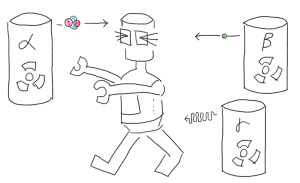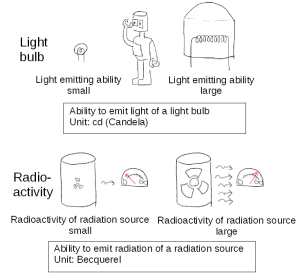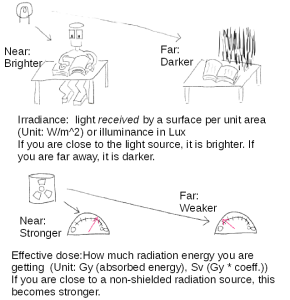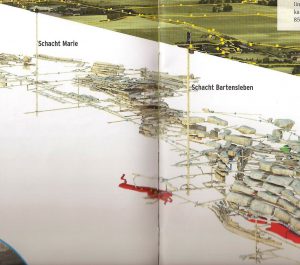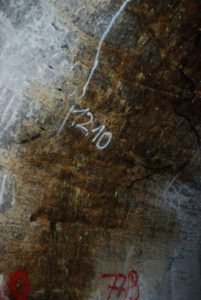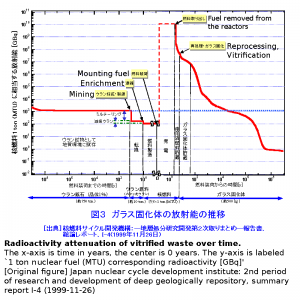The budget of long term waste management
The budget for long term waste management depends on the country. Typically, the power companies that have nuclear power plants pool the budget for the back-end process. The size of the pool is based on the electricity fee. This is the user-pays principle: Someone who has a benefit must pay for it. This means that the consumers of electricity from the reactors pay for the decommissioning of the reactor and the long term waste management.
In Germany, the power companies pool the back-end budget of around 30-36 billion Euro. It seems that Germany has the largest back-end budget in the world, still there is no guarantee that it is large enough.
In Japan, some back-end budget is pooled, however, there is no budget for the long term storage. Since the Japanese plan assumes that the nuclear cycle will be established soon, and the nuclear cycle assumes that there is no nuclear waste (MOX used fuel).
In any case, the budget is most probably not enough and the people who did not use the energy need to pay the debt.
The status of long term waste management in the world
A final disposal facility for high level nuclear waste has not been implemented yet in the world (as of November 2014). The Onkalo used nuclear fuel repository on the west coast of Finland will be the world’s first deep geological repository for used fuel final disposal. It is currently under construction and planned to begin operation use around 2020. Here we summarize the current status of Germany and Japan.
The final used fuel disposal plan in Germany
For low-, middle-level nuclear waste final disposal, there were following plans in Germany. However, still many problems should be sorted out.
Schacht Konrad
- 1000m deep under ground
- Originally, this was an iron mine. The upper part is clay stratum.
- The permission of operation has been issued. Use is planned for 2017. However, there are unresolved technical issues. There is a large possibility that the plan would be delayed.
Morsleben (at ex East Germany)
Asse (at ex West Germany)
- 1000m deep under the ground
- The deployment was begun in order to test whether the rock salt stratum is suitable for the purpose.
- Water leaking was found. High level nuclear waste disposal was found. It was planed to remove all the nuclear waste.
Germany investigated the location of deep geological repository of high level nuclear waste at Gorleben. However, the discussion was cleared up. After that, the deep geological repository investigation committee has established and the committee representing many areas was gathered. Here is the current plan:
- July, 2013, the law of how to decide the location of the final disposal facility.
- The ministry of the final disposal facility has been established.
- The procedure how to decide the location of final disposal facility will be established at the end of 2015.
- The operation of the facility will be started in 2035. (Updated May 2015: The committee mentioned the operation of the final disposal facility should be postponed after 2170 due to not enough backend budget.)
At Gorleben, the stratum of Rock salt under 1000m from the ground was investigated. However, how to proceed is not clear yet.
In Germany, the first plan was an eternal repository. But the plan has
been changed. The operation time of the current plan is 1,000,000
years. For the first 500 years, we can still have access to the used
fuel. This is in case we could develop a technology to make the used
fuel innocuous in the first 500 years.
The final disposal plan in Japan
In Japan, the low level final nuclear waste disposal facility is in operation at Rokkasho-mura. The maximal depth of this repository is 100m.
Japanese plan of high level used fuel disposal is based on the assumption that the technology for a nuclear fuel cycle can be established soon. This means the reprocessing of the used fuel is a prerequisite and then the final disposal facility would not be necessary anymore. After the Fukushima’s accident, the discussion about establishing a final disposal facility raised, there is no concrete plan however of the final disposal yet both for used fuel and vitrified waste (as of May 2015).
A part of the high level nuclear waste is vitrified waste. 40,000 containers of vitrified waste will be produced in 2020 (estimate). For this waste, the government officially asked all the cities to be voluntarily a candidate location for the final disposal facility. There were around 10 candidate locations, but most of them were retreated and there is none as of December 2014. (Updated May 2015: The government gave up the public offering and has decided that the choice of the location will be up to the government [1].)
There are a few research facilities for a deep geological repository. At Horonobe-city in Hokkaido, the research is on going on a clay stratum, at the depth of more than 350m. At Mizunami-city in Gifu, a granite stratum at the depth of around 500m is being investigated.
However, Japan is a country with lots of ground water and has frequent earthquakes compare of to other countries. It is hard to find the location where “There is no ground water and the stratum is stable for more than 10,000 years.” The existence of ground water and the possibility of earthquakes are not well suited for a final disposal facility. This is a problem for Japan.
Yamauchi’s memorandum
Middle-/Low-level final disposal nuclear waste facility will be investigated in Miyagi prefecture [2] (Updated December 2014). This waste was the product of a decontamination process.
Principle of final disposal of spent fuel
The principle of final nuclear waste disposal is “In land and the user pays.” The consumers who actually used the electricity should pay all the cost. We should not pass this negative legacy to the next generations. But, it is not possible to avoid this anymore. We have a debt to the future.
What we could still do is, for instance, to invest in clean energy technology to alleviate the burden on the next generations. In our generation, we will not be able to finish the clean up of the negative legacy, i.e., reactor decomissioning and final waste disposal. Therefore, one way to decrease the next generation’s burden is to invest in sustainable energies and distribute the cost between the generations. Otherwise, the energy cost is not fairly distributed between the generations. If the generations of nuclear reactor put the cost to the next generation, the next generation will suffer from their development.
Yamauchi’s memorandum of the final disposal
Here is a conclusion including my personal opinions.
A nuclear power plant cannot run forever. Thus one day we need a decomissioning and a final waste disposal. This is independent of agreeing with or not for nuclear power. This is just a fact: a human made object will not stand forever. Fundamentally, human activity produces garbage.
The nuclear fuel cycle plan is based on an assumption that does not produce used fuel. The research into the nuclear fuel cycle in Japan spent more than 40 years and 100 billion yens, the prospect of the plan still does not stand [3]. I think we need a new plan since the assumption seems to have a problem. Many of the countries realized this problem and most of them have retracted the plan. Even if a nuclear fuel cycle plan is established, the reprocessing produces high level nuclear waste as vitrified waste. The amount of this high level waste is increasing (ref. a report of the federation of electric power companies of Japan [4]). This means we cannot avoid two negative legacies: decomissioning and final nuclear waste disposal.
I mentioned the “user-pays (beneficiary pays) principle”. This principle is for our future development. I think the energy problem is not a public service problem since the industry has a large role in energy consumption. We would in theory ignore the principle: Essentially we would not care about the future of our children and our country in order to gain something right now. Since these children do not exist yet, it is possible to have a democratic decision without them. I must ask this myself, is it ok? We elect governments that make a lot of debt for the future without a plan to pay it up. We could even decide that we do not want to return the debt. However, such people would lose trust. This means no more investment, since investors expect returns. I think we should think more about the meaning of the “user-pays principle.” If no investment is expected, we need a sustainable future, but what we are doing (living on the debt) is not sustainable.
It is not easy to find the information about the backend budget of Japan. (The backend budget for nuclear power plant is the budget for clearing up the plant: decomissioning, fanal disposal of waste, and so on.) The backend budget is about the user-pays principle. Today’s backend budget of Germany is 30 – 36 billion Euro (4 trillion yen as 136 yen/euro as of today (2015-7-3)). This is now considered not sufficient. According to the article [7], all the Japanese power companies as a whole should set aside 1.5 trillion yen for the decomissioning budget. The backend budget includes final waste disposal besides decommissioning. I am interested in how much backend budget the Japanese have set a side. I have not been able to find this information yet. Please notice that budget of Japan and Germany cannot be easily compared, since Japan has more than the twice reactors of Germany. The article [7] pointed out that Japanese power companies have a plan to collect the budget deficit even after the decommissioning. This means the people who did not use electricity will pay the backend budget as electricity fee. According to this plan, the nuclear energy fee cannot cover the whole life cycle of the nuclear energy, so fossile/water/solar power sources will cover the nuclear’s energy. I think the user-pays principle does not hold here. Moreover under the current law electricity consumers have no choice but to pay for the nuclear power life cycle via another type of energy. Our children have no choice as well, they need to pay for non-used electricity fee. I don’t find acceptable that they say “Here, there is some cheap stuff, use it!” then later say, “Hey, you have hidden debt because of that. Your children and grandchildren must also pay for that.” I also find hard to imagine, how our children and grandchildren look at it. Because of this, I find the backend budget an intersting item. I think that if someone uses them, he/she should also pay for it.
This is my personal opinion: I’d rather stop the investment to make the old system to just survive for a short time. It will be a burden to the country’s economic system. We can get a small gain for a few years span, but then we have a long term suffering negative effect. It’s this kind of effect that can cause the collapse of a country. I hope we are able to clear up the negative legacy as early as possible.
Another drawback of nuclear plants is negative effect for national security. One of the reasons that the U.S. have a hard time building a new nuclear plant is not only the cost itself, but also the security. You can find a discussion considering the terrorist danger for the nuclear plant [5]. In this discussion, nuclear power plants are good target for terrorists as a country can easily lose a large part of the land. On the other hand, natural energy, i.e., solar, wind, etc. is way safer in case of terrorism and war. Personally, I do not have enough knowledge to numerically evaluate this kind of cost, although some other countries have discussion this kind of costs. We could also consider them.
I would like to think about what future I would like to have, how we can decrease the negative legacy for our children, what can I do for that. I wish we and our children could have sustainable development in our future.
(Update: 2015-6-26(Fri) Ministry of Economy, Trade and Industry (Yoichi Miyazawa, Minister of Economy, Trade and Industry) agreed to establish the working group of “Nuclear cycle operation” to discuss how to continue the nuclear cycle development [6].)
References
- Asahi Shinbun (朝日新聞), “The govenment leads to choose the waste processing site. [Promised location] was presented. The cabinet’s decision (国主導で原発ごみ処分地選定、「有望地」提示 閣議決定)(2015-5-22), http://www.asahi.com/articles/ASH5Q335KH5QULBJ002.html, [Online; accessed 2015-7-2]
- Kahoku shinpou (河北新報), The governor of Miyagi has accepted the candidate’s investigation of the final waste disposal (宮城県知事,詳細調査受け入れ 最終処分場 2014-8-5), http://www.kahoku.co.jp/tohokunews/201408/20140805_11016.html, [Online; accessed 2014-12-22]
- Tokyo Shinbun (東京新聞), Spent 45 years and 100 billion yen. Nuclear fuel cycle has no concrete plan yet. {45年で10兆円投入.核燃サイクル事業めどなく), http://www.tokyo-np.co.jp/article/feature/nucerror/list/CK2012010502100003.html, [Online; accessed 2014-10-04]
- The Federation of Electric Power Companies of Japan (電気事業連合会), Nuclear power plant (原子力発電について): Vitrified radioactive waste (ガラス固化体), http://www.fepc.or.jp/nuclear/haikibutsu/high_level/glass/, 2014, [Online; accessed 2014-12-21(Sun)]
- Amory Lovins, A 40-year plan for energy, TEDSalon NY2012, http://www.ted.com/talks/amory_lovins_a_50_year_plan_for_energy, [Online; accessed 2014-12-22]
- Asahi Shinbun (朝日新聞), Return to the nuclear power. Question on restarting the reactors 4: Nuclear fuel cycle office is looking for reopening the process (原発回帰 再稼働を問う:4核燃サイクル、再開にらむ (2015-7-11(Sat)), http://digital.asahi.com/articles/DA3S11852879.html, [Online; accessed 2015-7-11]
- Nishi-nippon Shinbun (西日本新聞), 40 percent deficit of nuclear decommisioning budget, Fill the budget by after the decommisioning through the electricity fees, investigated the back end budget of 9 power companies (原発解体費4割不足 廃炉後も電気料金で穴埋め 電力9社積立金調査 (2014-10-20)), http://qbiz.jp/article/48036/1/, [Online; accessed 2015-7-3]
